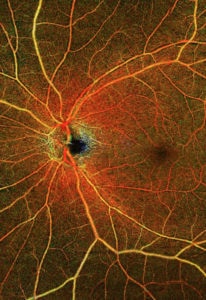Macular Degeneration
Age related macular degeneration (AMD) is the most frequent cause of severe visual loss in the over 55 year age group and sometimes requires urgent medical treatment.
600+ 5-Star Patient Reviews:


What is Macular Degeneration?
Age related macular degeneration (AMD) is the most frequent cause of severe visual loss in the over 55 year age group and a condition that often co-exists with many other eye conditions e.g. cataract or glaucoma. AMD is generally divided into two types, ‘dry AMD’ which is the more widespread and a milder form of AMD and ‘wet AMD’ which is more rapidly progressive and can cause sudden and profound visual loss. Wet AMD requires urgent medical treatment.
David Anderson is not a retinal or macula disease specialist but works closely with experts in the treatment of AMD and retinal conditions so you will receive prompt expert advice and care should you require treatment or further investigation.



Types of Macular Degeneration
Dry AMD
Dry AMD represents the majority of cases of AMD and is typically milder than wet AMD. Patients may experience no symptoms with findings of AMD observed during a routine sight test at an Optician or by an OCT (optical coherence tomography) scan. The presence of drusen, small yellow deposits at the macula are an early sign of AMD.
Wet AMD
Wet AMD is a more advanced form of AMD accounting for around 10% of all cases of AMD. It is caused by new blood vessels growing into the retina under the macula and bleeding, leaking fluid or causing scarring. Wet AMD is often treated by injections into the eye with a class of drug called an anti-VEGF agent. VEGF stands for vascular endothelial growth factor and is a substance produced normally by the body to encourage new blood vessels to grow in a healing response. In wet AMD however, this response causes harm rather than help as the new blood vessels can leak or bleed under the surface of the macula causing visual loss or distortion of vision.
Wet AMD can cause a variety of symptoms but metamorphopsia or distortion of the central vision is an important sign that urgent treatment may be required, other symptoms include sudden blurring of vision or seeing objects as being larger or smaller than they should be. These symptoms can be charted using a grid of squares called an Amsler grid – see below.
If you have signs of wet AMD you require urgent medical assessment in a specialist AMD clinic.
Macular Degeneration Treatment
Dry AMD
Current treatment for dry AMD focusses on reducing risk factors e.g. smoking cessation, losing weight and improving diet. Diets which contain high levels of antioxidants called carotenoids such as leafy greens, carrots, broccoli, raw spinach etc. are thought to lower the risk of developing AMD. For patients with moderate AMD certain high dose vitamins have been shown to reduce the risk of progression, these are called AREDS II vitamins such as VitEyes 2.
Although there are no widely available treatments for dry AMD a treatment called Photobiomodulation (PBM) or Red Light Therapy using the Valeda Light Delivery System by LumiThera® has been shown in some studies to both improve visual acuity and contrast sensitivity and reduce the thickness of retinal drusen. The light is a mixture of red, yellow and infrared light and treatment consists of treatment cycles on an outpatient basis. Treatment is painless. Large scale studies are in progress across Europe and the USA to evaluate the effectiveness of this treatment to evaluate whether PBM can slow down the progress of dry AMD.
Further information regarding can be downloaded here.
Wet AMD
Wet AMD is often treated by injection or series of injections into the eye using a class of drug called an anti-VEGF agent.
A variety of anti-VEGF agents may be employed to treat wet AMD including Lucentis® (Ranibizumab), Avastin® (Bevacizumab) and EYELEA® (Aflibercept). The advantages and disadvantages of treatment with each agent should be discussed with your medical retina specialist. Further information about anti-VEGF treatment can be found on the RNIB website here or the Macular Society website here.
Macular Degeneration FAQs
These are some of the questions we are often asked about AMD:
AMD affects around 2% of the population older than 65 years in Europe and around 25,000,000 people worldwide. ‘Wet’ AMD represents about 10% of all cases of AMD.
Dry AMD represents the majority of cases of AMD and is typically milder than wet AMD. Patents may experience no symptoms with findings of AMD observed during a routine sight test or by an OCT (optical coherence tomography) scan. The presence of drusen, small yellow deposits at the macula are an early sign of AMD.
At the present time there is no known cure for dry AMD but a number of studies suggest that diet can play an important role in reducing the risk of developing dry AMD or reduce the risk of it progressing.
AMD is monitored through a combination of clinical examination including a visual acuity test, use of an Amsler Grid, a dilated eye examination and typically non-invasive OCT scanning. OCT’s have become highly sophisticated and can provide highly detailed, often 3D images of the retina and macular. OCT scanning is now performed by many Opticians as part of a more detailed eye examination in addition to measuring the spectacle prescription.

Multi-modality retinal imaging with OCT-Angiography (OCTA). Image courtesy of Carl Zeiss Meditec, Inc.
Other ways of investigating AMD include the use of fluorescein angiography where a yellow dye called fluorescein is injected into a vein and a series of photographs are taken as the dye moves through the retinal circulation.
AMD can affect your ability to drive safely and you must fulfill the minimum standards of vision for driving which can be found here.
You are required by law to tell the DVLA about your condition if AMD affects both of your eyes or if it affects one eye but your remaining vision falls below the minimum standard required. You can do this by following this link.
David Anderson supports the Gift of Sight Appeal based at University of Southampton and Southampton Eye Unit, its mission is to fund and produce world-class research into the prevention and treatment of blindness and can be reached through this link: https://www.giftofsight.org.uk/
This page is intended to provide general information about AMD and not medical advice. If you suspect that you have AMD or in particular have developed wet AMD you will require assessment by a specialist in AMD within two weeks.

